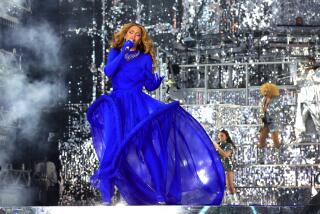Renaissance Musicians Love New York, but Feeling Isn’t Always Mutual : Entertainment: <i> A cappella </i> singers get thrown out of the best places. The trouble is that most audiences today just aren’t in tune with the 15th Century.
- Share via
NEW YORK — John Hetland and his entourage have been thrown out of some of the most prestigious spots in Manhattan: the United Nations building, the Metropolitan Museum of Art, Avery Fisher Hall.
“I realized that you can’t just walk into the Met and start singing Renaissance music,” Hetland said in retrospect.
But, since 1973, the Renaissance Street Singers--a group of amateur performers that he directs--has been performing anywhere they can. The singers travel from the grandeur of the Cathedral Church of St. John the Divine to grimy subway platforms.
The 15 singers take to the streets every Sunday to present two hours of motets a cappella . In other words, they sing sacred music, often in Latin, from the 15th and 16th centuries--without instrumental backup.
Most members of the group have experience in a church choir. New singers must audition and be able to read music and attend practice on Thursday nights.
A professional voice coach warms them up before practices to work toward a refined level of synchronization.
This form of music layers voices over one another, blending independent melodies that swell into one harmony. Motets, which originated as far back as the 13th Century, were sometimes secular, but often they were written for a particular holy day.
Joel Ockeghem, who started a group in the late 1960s that led to the Renaissance Street Singers, said that the “resonance” of Renaissance music makes it especially appealing to the ear.
“Resonance synchronizes the nerve response to sound,” he said, explaining that this makes different voice layers sound unified. “If you hear a correctly intoned sound, immediately you are highly stimulated,” said Ockeghem, who has taught at the Manhattan School of Music.
The group accepts no donations from onlookers, but art has its price. Occasionally, hecklers emerge from the audience to mimic Hetland as he conducts. And, once, a disgruntled listener protested their policy of not affiliating the music with a particular religion.
He wrote Hetland a letter: “I stopped by to listen to your group sing recently at the Grand Central Terminal, and, reading your purpose, I would earnestly plead with you to seek the reality of salvation.”
But the group plods on. “Sometimes we earn our crowd minute by minute,” said Hetland, a computer programmer for Manufacturers Hanover Trust Co. But sometimes, as soon as an off-note is hit, he will see someone in the audience melt into the crowd of passersby and walk away.
“I think a lot of people stop not because they want to hear Renaissance music but because here are people doing something funny on the street,” said Nancy Mandel, a Parsons School of Design student who has belonged to the group for more than seven years.
Renaissance music holds its own when it comes to sales of classical-music recordings, according to Paul Tai, manager of Tower Records classical music department in Manhattan. “It’s not as popular as opera,” he said, although sales have increased in the last few years.
Although curious onlookers and music aficionados might hover around the singers in Sheridan Square in Greenwich Village, they wouldn’t necessarily pay for a concert of motets, said Crail Conner, program manager for the Manhattan-based National Choral Council.
“You can’t sell it,” Conner said. “The concert scene is in slight decline because of the funding problems,” she added, citing cutbacks in the number of grants available.
“You’re just not going to break even,” she said. “We’re losing a lot of beautiful music that way.”
And, because people tend to enjoy what they are familiar with, Americans are more likely to be in tune with the popular music inundating the airwaves, according to Dwight Blocker Bowers, an entertainment historian at the Smithsonian Institution in Washington, D.C.
“Tastes in music are largely determined by record companies and other factors of big industry,” Bowers said. So, when it comes to Renaissance music, “It’s not as accessible to the man on the street.”
This is exactly the audience the Renaissance Street Singers try to reach. Renaissance composers like William Byrd will probably never be household names.
In the process, the core group of singers has grown as close as family. Hetland met his live-in companion in the group, and several other couples who met there have married.
Still, Jeannette Johnson, another longtime member, said: “It’s less of an adventure. (Now) we don’t even go out when it rains.” She remembers when the Renaissance Street Singers would wander all over Greenwich Village, instead of the few “regular” spots where they now perform.
Rain may hamper the performers, but requests to move along don’t daunt them. “It’s always something like, ‘I think it’s beautiful but my boss wouldn’t appreciate it,’ or, ‘You can’t come in here and sing,’ ” said Hetland, recounting the excuses he has been given.
“I think without music I would feel very lost and useless,” he said. “It’s the most important thing in my life.”
More to Read
The biggest entertainment stories
Get our big stories about Hollywood, film, television, music, arts, culture and more right in your inbox as soon as they publish.
You may occasionally receive promotional content from the Los Angeles Times.










